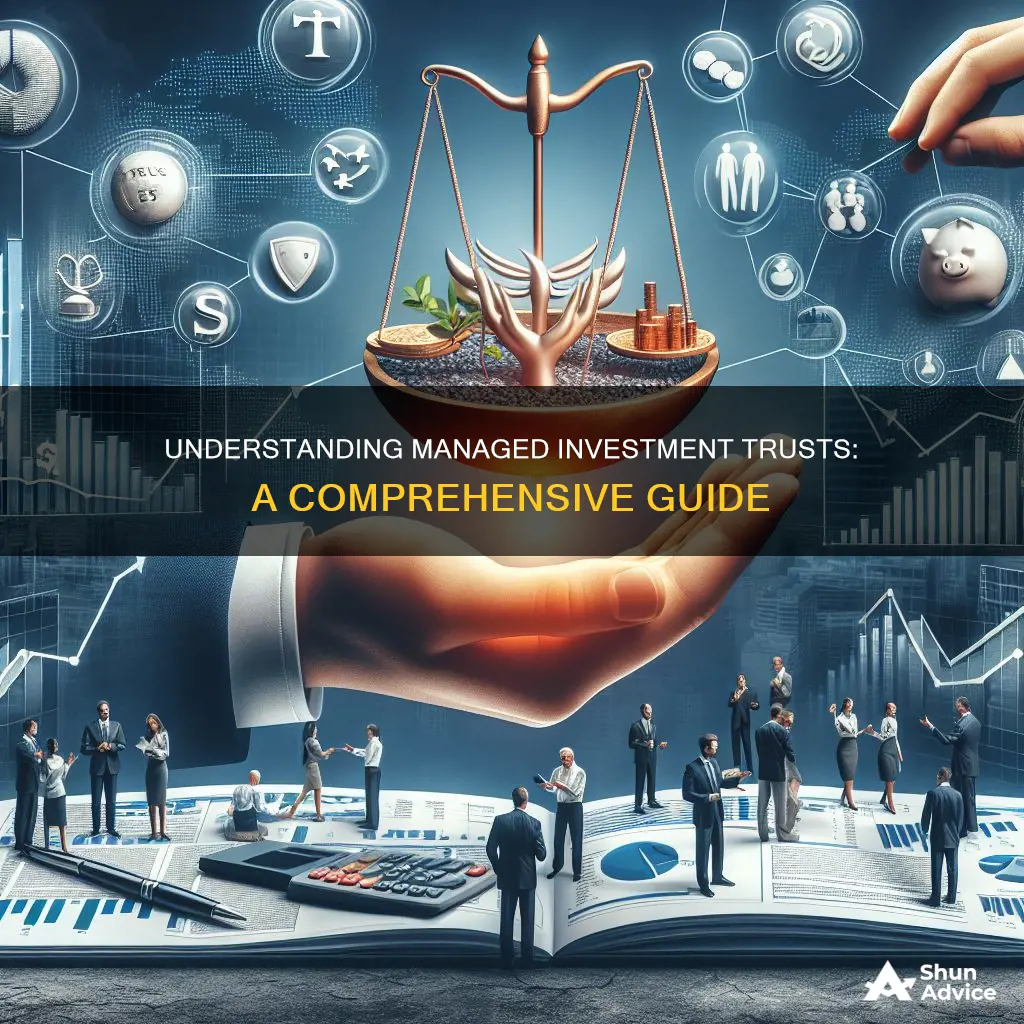
A managed investment trust (MIT) is a type of trust where members of the public pool their money to invest in passive income activities, such as shares, property, or fixed-interest assets. A fund manager then buys and sells these assets on their behalf. The key benefit of an MIT is that it allows foreign investors to access a concessional withholding tax regime. Under Australian law, an investor can make an investment directly or through an investment vehicle, such as a company, a trust, a joint venture, a managed investment scheme, or a partnership. The choice of investment method depends on the desired commercial requirements of a transaction and the resulting tax implications.
| Characteristics | Values |
|---|---|
| Type of Trust | Members of the public collectively invest in passive income activities |
| Investment Types | Shares, property, or fixed interest assets |
| Taxation | Generally taxed under the trust provisions in Division 6 of the Income Tax Assessment Act 1936 (ITAA 1936) |
| Taxation Requirements | Beneficiaries are taxed on their share of net income or the trustee is taxed on their behalf, based on the 'present entitlement' of beneficiaries to trust income |
| Eligibility Requirements | Ownership requirement and investment management requirement |
| Ownership Requirement | The trust must satisfy a widely held ownership requirement and must not be closely held |
| Investment Management Requirement | A 'substantial proportion' of the 'investment management activities' must be carried out in Australia |
| Key Benefit | Access to the concessional withholding tax regime |
What You'll Learn

Taxation of MITs
The taxation of Managed Investment Trusts (MITs) is a complex area, and the Australian Taxation Office (ATO) provides detailed guidance on the subject. One key aspect of MIT taxation is the withholding tax regime. Under this regime, foreign investors who are residents of countries with an effective exchange of information on taxation matters with Australia are eligible for a reduced withholding tax rate on fund payments from a MIT. The rate varies depending on the residence of the investor. For countries with an information exchange agreement, the rate is 15%, while for those without such an agreement, the rate is 30%.
Another important consideration for MITs is the arm's-length income rule, which was introduced in the context of the repeal of Division 6B of the Income Tax Assessment Act 1936. This rule aims to prevent the shifting of profits from an active business of a related party to a MIT through non-arm's-length activities. If the ATO determines that a MIT has derived non-arm's-length income, the trustee may be liable to pay income tax at the standard corporate tax rate of 30%. Non-arm's-length income is defined as income derived from a non-arm's-length scheme, where the amount received is more than expected if the parties had dealt at arm's length.
In addition, MITs and custodians may be required to withhold an amount from fund payments made outside Australia or to recipients with addresses outside the country. This withholding amount is considered a final withholding tax and is taxed at either 15% or 30%, depending on the recipient's country of residence. For MITs, a fund payment typically consists of the net income of the MIT from Australian sources, excluding certain amounts such as dividends, interest, and royalties.
The taxation of MITs also involves compliance with various eligibility requirements and regulatory provisions. The ATO provides detailed information on these requirements, including the widely held ownership requirement and the investment management requirement. Overall, the taxation of MITs is a complex and evolving area, and it is important for investors and trustees to stay informed about the latest regulations and requirements.
NRIs: Understanding the Portfolio Investment Scheme
You may want to see also

Eligibility requirements
A managed investment trust (MIT) is a type of trust where members of the public pool their money to invest in passive income activities, such as shares, property, or fixed-interest assets. To qualify as an MIT, certain eligibility requirements must be met for the income year the trust is in operation.
There are two critical eligibility requirements to access the managed investment trust regime:
Ownership Requirement
The trust must satisfy a widely held ownership requirement and must not be closely held under the applicable tests. This means that the MIT must be collectively owned by multiple investors, rather than a single entity or a small group of individuals.
Investment Management Requirement
A 'substantial proportion' of the 'investment management activities' must be carried out in the country where the trust is established. For example, in Australia, a significant portion of the investment management activities must occur within the country.
These eligibility requirements are essential for a trust to be considered a managed investment trust and access the associated benefits, such as the concessional withholding tax regime offered by MITs in Australia.
Saving and Investing: Your Path to Financial Freedom
You may want to see also

Investment management
A managed investment trust (MIT) is a type of trust in which members of the public collectively invest in passive income activities, such as shares, property or fixed-interest assets. A key benefit of MITs is the access they provide to the concessional withholding tax regime. Under this regime, foreign investors who are residents of a country with which Australia has an effective exchange of information on taxation matters are eligible for a reduced rate of withholding tax on fund payments from an MIT. The rate of withholding tax depends on the residence of the investor.
There are two critical eligibility requirements to access the managed investment trust regime: the ownership requirement and the investment management requirement. The ownership requirement dictates that the trust must satisfy a widely held ownership requirement and must not be closely held under the applicable tests. The investment management requirement states that a 'substantial proportion' of the 'investment management activities' must be carried out in Australia.
The role of the Trustee of an MIT includes responsibility for the compliance and governance of the trust, ongoing satisfaction of legislative and regulatory requirements, overseeing the operations and administration, holding title to the trust's assets, and operating the trust's bank accounts.
MITs (and their members) are generally taxed under the trust provisions in Division 6 of the Income Tax Assessment Act 1936 (ITAA 1936). Under these provisions, beneficiaries are taxed on their share of the net income of a trust, or the trustee is taxed on their behalf, based on the 'present entitlement' of beneficiaries to trust income.
On 5 May 2016, the Australian government enacted changes to the taxation of MITs. Eligible MITs may elect to apply the new rules for an income year starting on or after 1 July 2015. Once a MIT elects in, the trust provisions in Division 6 will no longer apply, and the MIT is referred to as an attribution managed investment trust (AMIT). AMITs are generally taxed under Division 276 of the Income Tax Assessment Act 1997 (ITAA 1997).
Meeder Investment Management: Is It a Reliable RIA?
You may want to see also

Trustee responsibilities
A managed investment trust (MIT) is a type of trust where members of the public collectively invest in passive income activities such as shares, property, or fixed-interest assets. The trustee of an MIT has several responsibilities, including:
- Compliance and governance: The trustee is responsible for ensuring the MIT complies with all relevant laws and regulations. This includes ongoing legislative and regulatory requirements, such as the eligibility requirements to access the managed investment trust regime.
- Operations and administration: The trustee oversees the day-to-day operations and administration of the MIT, including holding title to the MIT's assets and operating the bank accounts.
- Tax obligations: Trustees are responsible for ensuring that the MIT complies with tax obligations, which may include withholding tax on fund payments and changes to the taxation of unit trusts.
- Investment management: A substantial proportion of investment management activities must be carried out in Australia for the trust to qualify as an MIT. The trustee is responsible for overseeing these activities and ensuring they meet the required standards.
- Risk management: The trustee should ensure that the MIT's investments are appropriately diversified and managed to minimise risk. This includes understanding and communicating the risks of investing in the MIT to beneficiaries.
- Beneficiary rights: Trustees are responsible for ensuring that beneficiaries' rights are protected and that they receive their entitled share of the net income. This includes providing regular updates on the MIT's performance and ensuring transparency in its operations.
Investment Manager Certifications: Essential Credentials for Success
You may want to see also

Investment types
A managed investment trust (MIT) is a type of trust where members of the public pool their money together to invest in passive income activities, such as shares, property, or fixed-interest assets. The fund manager then buys and sells these assets on their behalf.
There are two critical eligibility requirements to access the MIT regime:
- Ownership requirement—the trust must satisfy a widely held ownership requirement and must also not be closely held under the applicable tests.
- Investment management requirement—a 'substantial proportion' of the 'investment management activities' must be carried out in Australia.
There are thousands of managed funds to choose from, each with different risks and returns. Here are some of the main types of managed funds:
- Single-asset managed funds—these invest in a single asset class, such as shares, property, or bonds.
- Fixed-interest or bond funds—these generally invest in low-risk investments, including government bonds, bank bills, or mortgage-backed securities.
- Property loan funds—these invest in property loans (mortgages). Some funds are high risk, depending on the quality of the borrowers and the purpose of the loan.
- Share (equity) funds—these invest in listed companies in Australia, overseas, or both. These funds offer the potential for higher returns but also carry higher risks.
- Alternative investment funds—these include hedge funds and funds that invest in private equity, derivatives, and commodities. They can be high risk, so financial advice should be sought before investing.
- Mixed-asset or multi-sector managed funds—these funds invest in a range of different assets, typically around 85% in shares and property, with the rest in cash or fixed interest.
Building an Ally Investment Portfolio: A Guide
You may want to see also







